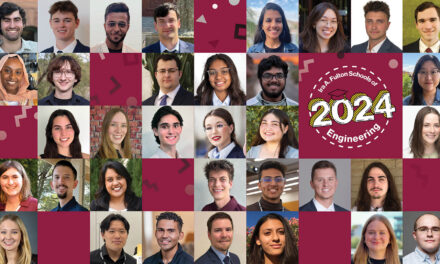
Moving microelectronics forward
Meet ASU students driving semiconductor advancement

Microelectronics have been at the forefront of a national conversation, in large part as a result of the COVID-19 pandemic. A global chip shortage during the rise of coronavirus infections forced the U.S. to confront the drawbacks of offshoring semiconductor manufacturing.
The problem has highlighted the importance of research projects such as those at the Secure, Trusted and Assured Microelectronics, or STAM, Center, directed by Michel Kinsy, an associate professor of computer science and engineering in the School of Computing and Augmented Intelligence — part of the Ira A. Fulton Schools of Engineering at Arizona State University.
Two STAM Center leaders, computer engineering doctoral students Mihailo Isakov and Alan Ehret, are working with Kinsy to build a foundation for future secure and trusted semiconductor and microelectronics technologies.
“Alan and I both met Dr. Kinsy while pursuing our doctoral degrees at other universities; we have followed him across multiple institutions. Dr. Kinsy is an incredible leader with an amazing dedication to his students, so following him here was not even a question,” Isakov says. “There was a lot of synergy for us to come to Arizona because of the access to semiconductor manufacturing and security experts. It’s probably the best place in the U.S. for our research.”

Mihailo Isakov, Artificial Intelligence Technology and Systems, or AITS, Laboratory research lead at the STAM Center.
The STAM Center has enabled Isakov to home in on machine learning, artificial intelligence, deep learning, hardware accelerators and introspection and self-aware systems as the research lead for the Artificial Intelligence Technology and Systems, or AITS, Laboratory.
With Kinsy’s encouragement, Isakov and Ehret are leading multiple exciting research projects, with Isakov’s work ranging from reimagining how supercomputers share information and collaborate with other machines to working with the MIT Lincoln Laboratory on radar image analysis and secure machine learning systems.
“There’s a certain joy to working with hardware; it has a real staying power,” Isakov says. “It’s amazing to be able to finish with a tangible end result like a chip. I have a love and appreciation for software as well, but working with hardware has been incredible.”
This past summer, Isakov was appointed as a W. J. Cody Associate at Argonne National Laboratory, where he collaborated on the design of particle accelerators and detectors for the European Organization for Nuclear Research, known as CERN.
In addition, his recent research paper, “A Taxonomy of Error Sources in HPC I/O Machine Learning Model” — which identifies where supercomputers are being underutilized and addresses any problem areas — was accepted for publication at this year’s SC22 International Conference for High Performance Computing, Networking, Storage and Analysis, the top conference in the high-performance computing field.
“Dr. Kinsy pushes all of us to explore as many areas of engineering as possible to become scientists, not just computer scientists,” Isakov says. “There’s a trap people can fall into where they think they can’t learn something that isn’t in their area of expertise. The mentality we have in the STAM Center is that you can learn anything if you apply yourself. It’s a very powerful feeling because I now have the skills to muscle into fields that I never would have seen myself in.”
Among their many research projects, Isakov and Ehret also contribute to a center-wide effort called Trireme. Ehret’s contributions to Trireme are some of his proudest achievements in his doctoral studies experience.
“Together with the other members of the STAM Center, I’ve been working toward the latest version of Trireme for more than five years now,” Ehret says. “It’s an in-house hardware platform, so anything at the STAM Center that needs a processor in it pretty much starts here. We use it as a design space exploration platform, so in many ways it’s the toolbox for all our architecture research.”
Trireme, a set of RISC-V-based processors and memory hierarchies, is the infrastructure at the center of many of the STAM Center research projects.

Alan Ehret, Computer Architecture and Embedded Systems, or CAES, Laboratory research lead at the STAM Center.
With RISC-V being an open and royalty-free instruction set architecture, or ISA, Trireme offers a high degree of customization and an attractive option for many applications, ranging from machine learning accelerators to secure computer systems design.
The resource allows students and researchers to experiment with RISC-V ISA features and quickly complete functional architectures, making it an extremely desirable tool to showcase at research conferences around the country.
“I was just able to showcase Trireme with Dr. Kinsy in Washington, D.C., at the Tapia 2022 Conference, which celebrates diversity and inclusion in computing,” Ehret says. “It’s been so rewarding to see this platform grow over the years. Now it is at a place where we can offer it as a resource and give tutorials to other universities that will use it for teaching and as a platform for their own research.”
In the STAM Center, Ehret is the research lead for the Computer Architecture and Embedded Systems, or CAES, Laboratory, where he focuses on hardware security and building anything needed for the center’s projects. As a senior researcher, he also has a mentorship role, guiding other students through their own research and helping them decipher projects that he has devoted years to understanding.
Ehret’s other research projects focus on ultra-low-power hardware and secure memory systems at the data center scale. In his thesis, he is exploring how to build a complete computing continuum, connecting edge and cloud systems such as a credit card reader and a data center for processing transactions. His work looks at how to unify these systems to support secure data sharing, protecting information such as credit card numbers everywhere from the checkout line all the way to the data center in the cloud.
“In addition to our research, the workforce development mission of the STAM Center is something that I’m proud of,” Ehret says. “We’re always recruiting motivated PhD students interested in cybersecurity. We are constantly networking with students to showcase the possibilities and opportunities out there. I’m excited to continue our outreach work at the STAM Center after I graduate as a principal investigator for the CAES Laboratory, where I will also help guide the deployment of our current chip design, manufacturing and testing efforts.”
The future of the center looks bright thanks to the CHIPS and Science Act of 2022 — passed in part as a result of the challenges brought on by chip shortages in the U.S. — which will encourage semiconductor manufacturing here.
“We’ve dedicated years of our lives to this research, so it’s very reassuring to know that Congress agrees this is a national priority,” Ehret says. “It’s incredible to see our center’s mission lining up with what our nation’s leaders care about. That’s a great feeling as a researcher. We look forward to what the future holds.”



































